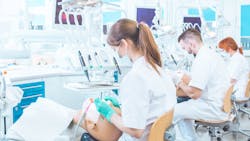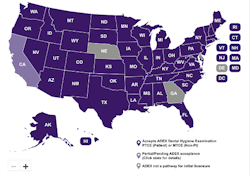Examining clinical competency: The past, present, and possible future of clinical board exams
The ever-evolving conversation surrounding dental hygiene licensure requirements has prompted a debate on whether previous historically accepted testing methods are ethical, and valid, in determining clinical competency of graduating students versus alternative methods. The current requirements for dental hygiene licensure, as outlined by the American Dental Hygiene Association (ADHA), are:
- Graduation from a Commission on Dental Accreditation (CODA) accredited dental hygiene program
- Successful completion of the written National Board of Dental Hygiene examination
- Successful completion of state or regional clinical board exams1
Historically, a live-patient examination (LPE) has been the selected measure of clinical competency. In previous years, this modality of testing has been scrutinized for being ethically unsuitable for determining clinical competency for dental hygiene licensure.
In 2011, the American Dental Education Association (ADEA) released a policy statement supporting the elimination of the live-patient examination for licensure and suggested that all states should offer other alternatives for determining clinical competency via nonlive patient-based methods; despite this policy statement, LPEs are still one of the most widely accepted testing formats accepted today.2 Following the COVID-19 pandemic, restraints have been placed on licensure examination methods to offer alternative assessments that are not live-patient-based. This has set forth the question of what alternative options are currently available to graduating dental hygiene students, which states around the country accept such options, and why we as a profession should care.
Live patient exams
Beginning in 1929, the Joint Commission on National Dental Exams (JCNDE) administered the first LPE to establish clinical competency for dental hygiene licensure.3 This criteria for obtaining licensure has remained for nearly 100 years in all states except Delaware.4 The desirable aspect of this testing format is that it directly evaluates the ability of a student to detect and remove calculus in a clinical setting on a live patient.
With this style of testing comes unavoidable risks, both physically and ethically, to everyone involved. While compiling the literature, the main concerns regarding LPEs are that they go against the code of ethics that dental hygienists are sworn in to uphold. In the ADA’s Resolution 64H, it reaffirms their position for the elimination of live-patient examinations. In this whitepaper document, the most common ethical violations of live-patient-based exams are outlined, such as coercion of the patient, delayed patient care, lack of continuance of care, and more. The purpose of the document was to provide ways to avoid infringements of the Code of Ethics when taking a live-patient examination.5 The need of such a document, in addition to compiled research that highlights how pervasive the ethical and physical risks associated with the LPE are, illustrates that such exams go against what we as a profession uphold ourselves to be. Advancements in the industry coupled with a global pandemic that created the need for new testing methods resulted in the implementation of beta runs of alternative clinical evaluations.
Manikin exams
The COVID-19 pandemic has made it clear that alternatives to LPEs would be critical for dental hygiene licensure. In 2020, a manikin-based method of determining clinical competency was released. A non-patient-based examination was conducted on a Commission on Dental Competency Assessment (CDCA) provided American Board of Dental Examiners (ADEX) typodont, simulating a live patient. With this method, two hours were allotted for calculus removal in one quadrant and subgingival calculus detection of another, as well as periodontal probing of two randomized teeth. Scoring was based on the student’s ability to detect and remove calculus and the accurate measurement of periodontal pockets.
Related reading:
Full manikin licensure: Our new (and improved) normal
Manikin exams: The game-changer we've been waiting for
The clear benefit to the manikin board is the removal of ethical qualms of the LPE while maintaining a standardized method of testing.6 It is widely accepted that the manikin exam is more standardized than a live-patient test. As opposed to LPEs, there are no true risks in the manikin format since it’s completed on a typodont rather than a live person. Following the release of this format for clinical boards, the response of the dental hygiene community has been largely positive, especially among graduating students and instructors as evidenced by a commission survey released after the launch of the manikin-based exam.7 New measures of testing clinical competency are gaining widespread support in the dental hygiene community.
OSCEs
The manikin board has sparked a wave of other alternative testing methods, the future of which will be the Dental Hygiene Licensure Objective Structured Clinical Examination (DHLOSCE), set to launch in 2024. The DHLOSCE, while still in the early stages of development, will be a nationwide clinical examination that will have no variation, creating a standardized measure of clinical competency. Unlike the manikin board, the DHLOSCE will not take place on a typodont, but will involve radiographs, photographs, and/or 3D models for students to demonstrate their knowledge and skills8. Trained actors will portray live patients in case-based sections but will not have the same level of risk as LPEs as they will not be used for calculus detection and removal.
No examinations?
With the 2024 DHLOSCEs eliminating not only live patients but also manikin typodonts, the new radical question is to whether clinical board examinations are necessary for dental hygiene licensure. According to "State licensing board requirements for entry into the dental hygiene profession," published by Johnson et al., “most dental hygiene directors believe it is unnecessary to have testing outside of a CODA approved program for licensure.”4 Moving forward, would it be out of the question to assume that CODA-accredited dental hygiene programs are sufficient in determining clinical competency of their students upon graduation? For now, we still need to understand current measures of testing to advocate and advance our licensure requirements.
Who accepts what?
Currently there are five main regional testing agencies that, in light of the pandemic, have looked to the future and adapted with the evolving measures of alternative testing: Council of Interstate Testing Agency (CITA), Central Regional Dental Testing Service (CRDTS), Commission on Dental Competency Assessments (CDCA), and Western Regional Examining Board (WREB), and the Southern Regional Testing Agency (SRTA). Of these agencies, all five have offered the manikin board as an option for testing.
Not every state has accepted these new means of testing. To alleviate the confusion surrounding this, CDCA and WREB have created an interactive infographic that highlights the states currently accepting the ADEX manikin examination (figure 1).9
Students should be aware of current testing methods available to determine and obtain specific state licensure. Professionals in practice should be aware of current trends in testing knowing the baseline expected of new hygienists entering the profession. Advancements in the profession do not necessarily begin after licensure; it can begin before that. Looking toward the future, self-regulation of dental hygiene licensure within CODA accredited programs may be a possibility, but everyone needs to be on board.
References
- ADHA. Licensure. Accessed February 6, 2022. https://www.adha.org/licensure
- ADEA. ADEA policy statements: Recommendations and guidelines for academic dental institutions. Accessed February 1, 2022. https://www.adea.org/about_adea/governance/Documents/ADEA_Policy_Statements__Recommendations_and_Guidelines_for_Academic_Dental_Institutions.html
- ASDA. Use of human subjects in clinical licensure examinations. Accessed February 1, 2022. https://www.asdanet.org/docs/advocate/issues/asda_white-paper_licensure_web_final.pdf?sfvrsn=a0a868dd_18
- Johnson K, Gurenlian J, Garland K, Freudenthal J. State licensing board requirements for entry into the dental hygiene profession. Accessed September 30, 2021. https://pubmed.ncbi.nlm.nih.gov/32354852/
- Ethical considerations when using patients in the examination process. Accessed September 30, 2021. https://www.mouthhealthy.org/~/media/ADA/Education%20and%20Careers/Files/ethical-considerations-when-using-patients-in-the-examination-process.pdf?la=en
- CDCA. 202 Dental hygiene manikin exam candidate information. Accessed February 6, 2022. https://www.cdcaexams.org/documents/manuals/Dental_Hygiene_ManikinExamCandinfo.pdf
- Walker T. Students and faculty extol the advantages of manikin-based testing. Accessed February 6, 2022. https://www.dentaleconomics.com/macro-op-ed/article/14202863/students-and-faculty-extol-the-advantages-of-manikinbased-testing.
- JCNDE. Dental Hygiene Licensure Objective Structured Clinical Exam (DHLOSCE). Accessed February 6, 2022, https://jcnde.ada.org/en/examinations/dental-hygiene-licensure-objective-structured-clinical-exam
- 2022 ADEX acceptance maps. Accessed February 6, 2022. https://www.cdcaexams.org/adex-acceptance-map/
About the Author
Breanne Mat, BSDH (c)
Breanne Mat, BSDH (c), is a senior dental hygiene student currently enrolled at Pacific University. She has a bachelor’s degree in integrative physiology from the University of Colorado, Boulder. After graduation she plans to stay in Oregon with hopes of returning to Colorado when the timing is right. Breanne is passionate about oral health care advocacy for children and hopes to provide dental care for children in need. She can be reached at: [email protected]
Olivia Moullet, BSDH (c)
Olivia Moullet, BSDH (c), is a senior at Pacific University's dental hygiene program. She was born and raised in the Pacific Northwest and doesn't plan on moving anytime soon. As graduation nears, Olivia is looking forward to using her licensure to create opportunities to improve her community through public health initiatives. Olivia can be reached at [email protected].

